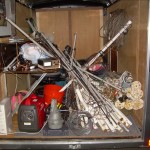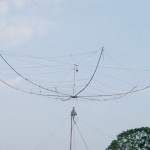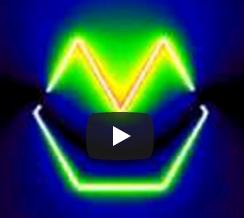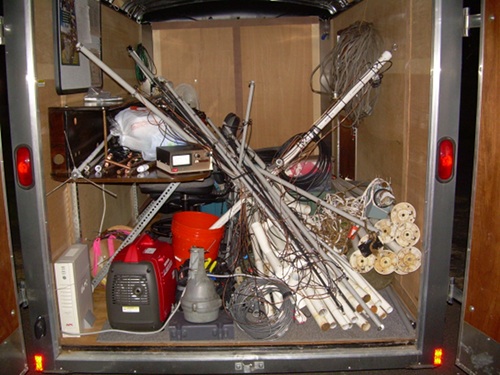ARRL Field Day 2010 was a blast. A member of our club bagged a satellite contact within two minutes of start time. Wow. One new item to this year’s operation was a G3TXQ Broadband Hex Beam antenna with elements for 20, 15, 10 and 6 meters.
We had a 3A operation this year plus one GOTA station. Things went smoothly.
One of the stations used an Elecraft K2 with an external power amp plus the 100 watt auto tuner. The Elecraft auto tuner provides two antenna ports. We connected a large dipole to channel 1 and left the other open for another antenna.
At some point during Field Day I decided things were going well enough for me to concentrate on my 20-15-10-06 meter hex beam of the G3TXQ variety.
As you can tell by the first photo below, the hex was hastily shoved into the trailer. However, I used good Flexweave wire for the elements and untangling the mess was straight forward. I decided the put the hex beam on the K2 station since it had the open antenna port and, for some reason, I think the K2 and the hex beam complement each other.
The hex beam was a bit loose in its rigging causing the elements to slump a bit. However, the thing tuned right up on 20, 15 and 10 meters similar to its debut during the Virginia QSO Party. Six meters was way off; I think the 10 meter wires were a bit too close to the six meter wires. No matter, the K2 had no 6 meters and 10 meters seemed to work well enough.
Results
Did it work? Boy it sure did. During my turn at the K2 Phone I found the hex beam provided two to four S units improvement against the dipole on 20 and 15 meters.
Late Saturday night I worked 4,800 mile contact with Hawaii (PAC) from Virginia with ease on 20 meters… on Phone! The Hex Beam and K2 bagged the only PAC contact of the four stations on site.
Several more 20 meter contacts were easily made to the West coast including LAX, SDG, SCV and WWA. I wish Field Day used Sections as multipliers, but I was glad to be able to add fresh contacts to the club’s totals. Tom, owner of the K2, quickly added many CW contacts using the beam.
The hex beam was up only about 15 feet and still worked quite well. Amazing.
We did have a rotator, but did not have it aligned with North. That was troubling, but I was just glad to be able to steer it at all at Field Day. We used a Channel Master TV type rotator. Yes, it works, but clearly is over stressed by the inertia of the hex beam despite its low mass. Anyone contemplating a rotator for their hex beam is well advised to “up” the rotator ratings quite a bit to ensure mechanical robustness.
Of all the compact compromise Yagi-Uda beam designs out there, I have to say the hex beam lives up to its own hype. There’s no magic in the hex beam (no matter what anyone tells you). It can’t outperform full size single band Yagi-Uda designs. However, for the investment, it is a superb value and deserves to be on anyone’s short list of antenna choices.
Choice Matters
The most important thing learned at this Field Day is having two antennas to select between makes a big difference in operating success. For some reason North Florida was alive with contacts and I sometimes used the hex beam and other times the wire dipole on 20 and 15 meters.
Yes, it’s Field Day and we tend to be minimalist. However, I designed this hex beam to be very portable and think it fits well with the Field Day theme with its simple tent peg tripod mount. It nicely complements a wire dipole.
The G3TXQ 20-15-10-06 meters Hex Beam antenna is a keeper for Field Days of the future.
















